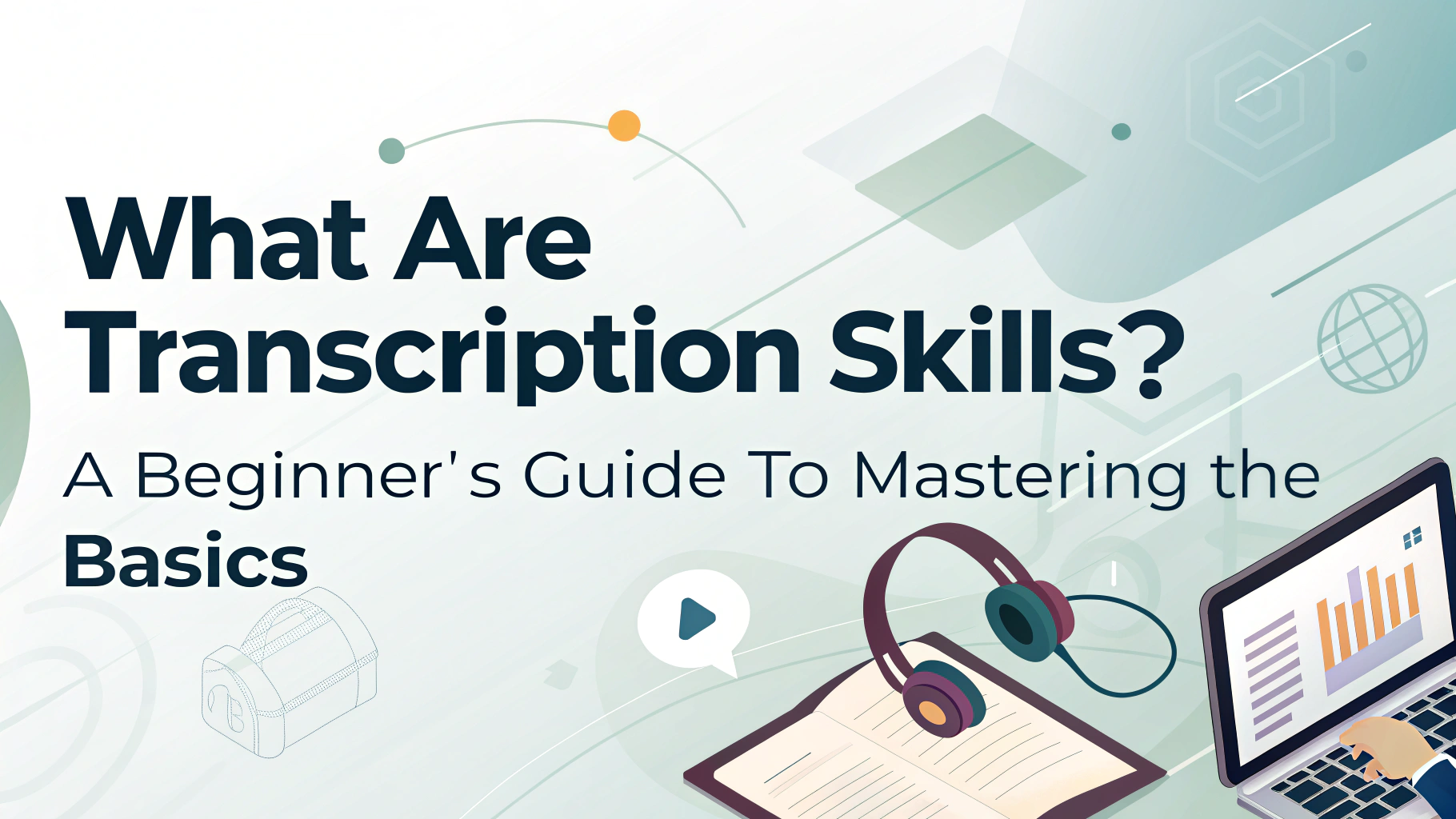Transcription skills are the essential abilities required to accurately convert spoken words from audio or video recordings into written text. These skills combine fast and precise typing, excellent listening, strong grammar, and attention to detail. Whether you’re working in legal, medical, media, or academic fields, transcription skills ensure you capture the speaker’s message word-for-word, clearly and efficiently.
Here is a guide to the 20 most important transcription skills.
Why Are Transcription Skills Important for Remote Work and Digital Content?
In today’s digital world, transcription is more than just typing. Businesses, researchers, podcasters, and content creators rely on accurate transcripts to improve accessibility, SEO, and documentation. As remote jobs rise and AI tools assist transcriptionists, mastering transcription skills is becoming a valuable career asset—especially for freelancers and virtual assistants.
Core Transcription Skills Every Beginner Should Learn
To become a successful transcriptionist, you need to build a set of foundational skills. Here’s what matters most:
✅ Typing Speed and Accuracy
You should aim for a typing speed of at least 60–80 words per minute while maintaining high precisione. Speed boosts productivity, but accuracy ensures clarity and professionalism.
✅ Excellent Listening Skills
Transcriptionists must listen carefully to different accents, audio quality levels, and overlapping speech. Active listening helps catch every word, even in noisy or fast-paced conversations.
✅ Strong Grammar and Spelling
Correct grammar ensures the transcript reads smoothly. Familiarity with punctuation, homophones, and sentence structure prevents misinterpretation of the spoken content.
✅ Attention to Detail
Missing even a single word can change the meaning of a transcript. Professional transcriptionists double-check their work to catch filler words, hesitations, or speaker tags.
✅ Time Management
Audio files are often long. Efficient transcriptionists know how to manage their time using breaks, batching, and shortcuts to stay productive.
✅ Familiarity with Transcription Software
Tools like Express Scribe, Otter.ai, VOMO, and Descript help manage playback speed, timestamps, and speaker labeling. Knowing how to use these tools gives you a competitive edge.
How to Develop Transcription Skills as a Beginner
Starting from scratch? Here’s how to build transcription skills effectively:
- Practice regularly with free audio files or YouTube videos. Start with clear speech and progress to more challenging accents or group discussions.
- Use speech-to-text software like VOMO to compare auto-generated drafts with your own edits. It’s a great way to spot mistakes and improve.
- Take online transcription courses on platforms like Udemy or Coursera. Many offer certification and real-world audio practice.
- Set typing goals using free tools like 10fastfingers or TypingClub to increase your speed over time.
- Analyze your own transcripts for grammar, spelling, and formatting issues. Self-correction is key to growth.
Which Industries Offer the Highest Transcription Income?
Transcription income varies widely depending on the industry, the complexity of the subject matter, and the level of expertise required. Here’s a comparison of common transcription industries ranked by average pay rates to help you understand where you can earn the most:
Generally, medical and legal fields require the highest level of accuracy, and these industries also offer the highest wages.
| Industry | Average Pay Rate (per audio hour) | Skill Level Required | Notes |
|---|---|---|---|
| Medical | $25 – $60+ | High | Requires medical terminology knowledge and HIPAA compliance. |
| Legale | $20 – $50+ | High | Needs understanding of legal jargon and formatting standards. |
| Corporate/Business | $15 – $40 | Medium | Often includes meeting minutes and conference calls. |
| Media & Podcasting | $10 – $35 | Medium | Fast turnaround and accuracy are essential. |
| Academic Research | $15 – $30 | Medium | Includes interviews, lectures, and focus groups. |
| General / Other | $10 – $25 | Low to Medium | Covers diverse content, usually less specialized. |
Note: Rates vary by experience, geographic location, and whether you work freelance or for an agency. Specialized fields like medical and legal transcription tend to offer the highest pay but require more training.
Career Opportunities and Freelancing in Transcription
Transcription is not only a valuable skill but also a viable career path, especially in today’s gig economy. Whether you’re looking to work full-time or as a side hustle, transcription offers flexibility, scalability, and a wide range of opportunities across different industries.
How to Become a Freelance Transcriptionist
To start a freelance transcription career, you’ll need a combination of typing speed, listening accuracy, and familiarity with transcription tools. Here’s a simple roadmap:
- Develop Essential Skills – Master grammar, punctuation, and active listening.
- Choose a Niche – Specialize in areas like medical, legal, or academic transcription to stand out.
- Use the Right Tools – Equip yourself with a reliable transcription software and quality headphones.
- Create a Portfolio – Include sample transcripts to showcase your accuracy and formatting.
- Apply for Gigs – Start on platforms like Rev, TranscribeMe, or Upwork.
Top Websites to Find Transcription Jobs
Here are some of the most popular platforms where you can find transcription jobs:
| Platform | Key Features | Payout Range |
|---|---|---|
| Rev | Flexible hours, fast application | $0.30–$1.10 per audio min |
| TranscribeMe | Easy entry for beginners, short files | $15–$22 per audio hour |
| GoTranscript | Global access, beginner-friendly | $0.60 per audio min |
| Scribie | Low barrier to entry, regular reviews | $5–$25 per audio hour |
| Upwork/Fiverr | Client-direct jobs, higher rates possible | Varies widely |
Note: The listed rates are approximate and may vary over time. Please refer to the official websites of each company or platform for the most up-to-date and accurate compensation details.
How Much Do Transcriptionists Earn?
Income varies depending on experience, industry, and workload. Here’s a rough breakdown:
- Entry-Level Freelancers: $10–$20 per hour (real-time)
- Experienced General Transcriptionists: $25–$45 per hour
- Medical/Legal Transcriptionists: $50–$75 per hour or more
- Full-Time Professionals: $30,000–$60,000+ per year
While transcription may not always start as a high-paying job, the potential to scale is significant—especially if you specialize or build long-term client relationships.
Transcription Skills for Medical Settings
Medical transcription requires a deep understanding of medical terminology, anatomy, and patient confidentiality. Accurate typing and familiarity with Electronic Health Records (EHR) systems are critical. Transcriptionists must also comply with HIPAA regulations to ensure patient data security. In this setting, even minor errors can have serious consequences, so precision is paramount.
Transcription Skills for Academic Interviews
When transcribing academic interviews or research recordings, attention to detail is crucial. Transcriptionists need to accurately capture complex terminology, accents, and academic jargon while maintaining context and structure for qualitative analysis. Capturing pauses, filler words, and tone can add value for researchers analyzing speech patterns and content.
Transcription Skills for Legal Proceedings
Legal transcription demands a strong grasp of legal vocabulary, courtroom procedures, and formatting standards. Precision is key, as even minor errors can impact legal outcomes. Confidentiality and the ability to work under tight deadlines are also essential. Mastery of legal jargon and exact transcription of testimony and depositions is necessary for court records.
Transcription Skills for Business Meetings
In business environments, transcriptionists must focus on clarity, speaker identification, and summarizing action items. Skills in fast typing, grammar, and the ability to discern key discussion points help convert spoken meetings into actionable, professional records. Formatting skills to present meeting minutes clearly are often requested.
Transcription Skills for Media and Podcasts
Media transcription requires the ability to handle varied audio quality, speaker overlap, and informal speech. Transcriptionists in this space benefit from strong editing skills, familiarity with timestamps, and understanding content repurposing for blogs, subtitles, or summaries. Quick turnaround times are often important to keep content publishing schedules on track.
Transcription Tools & Software
Best Transcription Software for Beginners
If you’re just starting out, choosing the right transcription software can save you time and improve accuracy. Here are some beginner-friendly options:
- VOMO.ai – A newer AI-based tool known for accuracy and speed, ideal for meetings and interviews.
- Otter.ai – Offers real-time transcription, simple editing, and speaker identification.
- Descript – Combines transcription with audio and video editing in an intuitive interface.
- Express Scribe – A classic tool with foot pedal support and hotkey features
These tools offer varying levels of automation, so beginners can pick one that suits their workflow and technical comfort.
Common Transcription Mistakes and How to Avoid Them
Even skilled transcriptionists slip up. Watch out for these common errors:
- Rushing and skipping difficult parts — use timestamps when unsure and return later.
- Assuming words instead of replaying unclear sections. Always verify what you hear.
- Inconsistent formatting — follow the client’s style guide (verbatim, clean verbatim, timestamp rules, etc.).
- Overusing auto-transcription — AI can help, but human review is essential to ensure accuracy.
- Not proofreading — always do a final read-through before submitting your work.
Final Thoughts: Start Building Your Transcription Skills Today
Transcription skills are valuable, learnable, and in growing demand. From typing and listening to editing and formatting, these abilities can open doors to flexible, well-paying remote jobs. Whether you’re a student, freelancer, or content creator, sharpening your transcription skills can help you work smarter and faster.
Want a tool that speeds up your transcription journey? Try VOMO — fast, accurate, and perfect for beginners.


